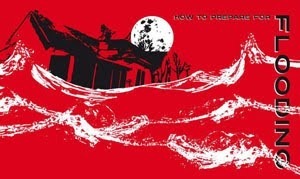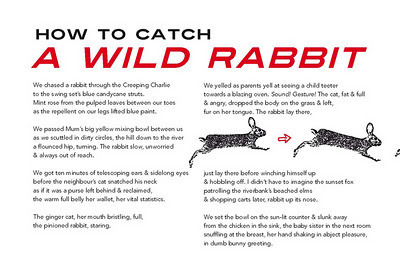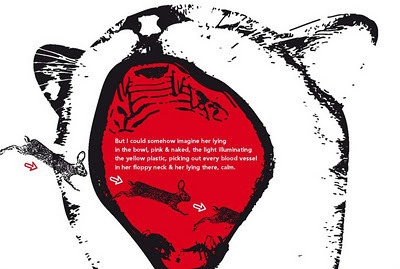Ariel Gordon's Blog, page 74
November 6, 2011
scabbed
Published on November 06, 2011 07:29
Extra marital mushrooming

All photos Riverstone Retreat, Durham, ON. November 5, 2011.
* * *
I always feel deeply conflicted about mushrooming in woods other than Assiniboine Forest. I've spent more than a decade shuffling its paths and am always trying to get there, no matter how busy or tired I might be.
But I'm STILL compelled, when traveling, to root around the trees, should there be trees nearby.
I was in Durham Ontario this past weekend for a writers festival, Words Aloud. Organizers put me and several other authors up at the Riverstone Retreat, where, in addition to the big house where we stayed, there was a campground.
Which meant that I could actually walk between stands of white cedar in the forest, that there were heaps of stump and downed trees.
It was a completely different forest from the boreal forest I grew up in and the aspen parkland I now inhabit. So I was glad that I was able to find specimens, that ultimately, mushrooming is mushrooming.
Published on November 06, 2011 07:11
November 1, 2011
Reprint: CBC's Manitoba Scene
Winnipeg poet prepares for flooding with poetry
Posted by Ariel Gordon, poet
I grew up in a house on the river in St. Vital.
That meant the lights and music of the Paddlewheel Princess on summer weekends and the awful clunk of metal on ice as my father cleared a rink come winter.

That also meant meant finding a perch somewhere during break-up every spring and listening to the thousand tinkling chandeliers, the thousand jaws crushing cubes.
Trees went by. Uprooted trees and unmoored docks and lawn chairs on giant slabs of ice.
Some years, the river corridor at the bottom of our property filled with water. That meant our basement was also flooded, and that our neighbours' basements were also flooded, and that once the water receded we'd all work to salvage what we could and pitch what we couldn't.
In 1997, I was living in Halifax and watched the wall of water approach Winnipeg frame by frame on the news. My father and his family were evacuated, just as my father and his family were evacuated during the 1950 flood.
How do you prepare for flooding? You install a sump pump and back water valve and hope that this year, it isn't your basement that gets the fallout of settling a flood plain.
If you're me, you write poems. Poems on "How to Prepare for Flooding" and "How to Survive a Plane Crash" but also "How to Sew a Button" and "How to Water Your Lawn Effectively" that are riffs on the wikiHows of the same names.
(Oh, and you find a brilliant designer to work when you're laying them out. And a nifty little chapbook press out of Saskatoon to publish them...)
Posted by Ariel Gordon, poet
I grew up in a house on the river in St. Vital.
That meant the lights and music of the Paddlewheel Princess on summer weekends and the awful clunk of metal on ice as my father cleared a rink come winter.


That also meant meant finding a perch somewhere during break-up every spring and listening to the thousand tinkling chandeliers, the thousand jaws crushing cubes.
Trees went by. Uprooted trees and unmoored docks and lawn chairs on giant slabs of ice.
Some years, the river corridor at the bottom of our property filled with water. That meant our basement was also flooded, and that our neighbours' basements were also flooded, and that once the water receded we'd all work to salvage what we could and pitch what we couldn't.
In 1997, I was living in Halifax and watched the wall of water approach Winnipeg frame by frame on the news. My father and his family were evacuated, just as my father and his family were evacuated during the 1950 flood.
How do you prepare for flooding? You install a sump pump and back water valve and hope that this year, it isn't your basement that gets the fallout of settling a flood plain.
If you're me, you write poems. Poems on "How to Prepare for Flooding" and "How to Survive a Plane Crash" but also "How to Sew a Button" and "How to Water Your Lawn Effectively" that are riffs on the wikiHows of the same names.
(Oh, and you find a brilliant designer to work when you're laying them out. And a nifty little chapbook press out of Saskatoon to publish them...)
Published on November 01, 2011 19:16
October 30, 2011
Out-of-Town-Authors: Ami McKay
O (for Oprah) CANADA
Talk show host played role in birth of writing career
Winnipeg Free Press - PRINT EDITION
by: Ariel Gordon
Nova Scotia-based writer Ami McKay is originally from Indiana. Two things made her a Canadian writer.
[image error] One, she wrote Oprah Winfrey a thank you letter, which resulted in an appearance on the talk-show host's program.
Two, she met and married a Canadian. During her wait for residency papers, McKay wrote The Birth House (2006), which would go on to become a Canadian bestseller and a favourite of book clubs.
McKay followed up on that success with the play Jerome: The Historical Spectacle (2008), which was staged in Nova Scotia and then published by Gaspereau Press.
McKay will read from her just-released second novel, The Virgin Cure, Tuesday at McNally Robinson Booksellers.
1) As a writer (i.e. someone whose artistic practice is predicated on time spent alone) how do you approach performance? What do you get out of it?
I suppose reading in public is a kind of performance, isn't it? Having been a music major in university, the word performance generally conjures up memories of voice recitals, orchestra concerts or musical theatre productions. I suffered from terrible stage fright back then -- dry mouth, sweaty palms, a pounding heart, the works. Thankfully, readings tend to be more relaxed affairs for me. I think of it as an opportunity to share the stories I saved up while I was alone, writing. It's a chance to share a few secrets and dreams, and if I'm lucky, and the conversation really gets humming, I'll get to hear a few secrets from the audience as well.
2) What do you want people to know about The Virgin Cure?
Although it's a story set in Victorian New York, the issues that sit at the heart of the novel are things we still struggle with in the present. Moth, the narrator and protagonist, could just as easily be a girl I saw standing on a street corner last week, or the at-risk teen who just ran away from home.
3) Will this be your first time in Winnipeg? What have you heard?
I was in Winnipeg for half a day a few years back, certainly not long enough to get to know the city. I've heard wonderful things about the arts scene here, especially when it comes to theatre and music. I'd love to spend at least a week wandering around and taking it all in. Maybe I'll come back in the summer. I hear the lightning storms are wickedly beautiful.
4) What are you reading right now? What are you writing right now?
I'm reading a fabulous, not yet released novel called The Winter Palace by Eva Stachniak. It's set in the earliest days of Catherine the Great and it's got me hooked.
I've been making notes for my next novel, The Witches of New York. It shares a few characters from The Virgin Cure but isn't a sequel in the traditional sense.
5) The Birth House was inspired, in part, by your house in Nova Scotia. The Virgin Cure is based, in part, on the life of your great-great grandmother, a New York-based doctor. Tell me a bit about the process of fictionalizing these real-life sites/people.
In both cases I found early on in my writing that truth really is stranger than fiction. Sifting through personal histories and archives, I stumbled upon many accounts of events that seemed so wild or incredible that I knew I couldn't have imagined them if I tried. The temptation, of course, is to pepper the narrative with every last one of those juicy tidbits. I had to learn to refrain from including things that didn't enhance or further the plot. I think (and hope) I'm getting better at only weaving what's necessary into the story and leaving the rest for another tale.
Ariel Gordon is a Winnipeg writer.
Talk show host played role in birth of writing career
Winnipeg Free Press - PRINT EDITION
by: Ariel Gordon
Nova Scotia-based writer Ami McKay is originally from Indiana. Two things made her a Canadian writer.
[image error] One, she wrote Oprah Winfrey a thank you letter, which resulted in an appearance on the talk-show host's program.
Two, she met and married a Canadian. During her wait for residency papers, McKay wrote The Birth House (2006), which would go on to become a Canadian bestseller and a favourite of book clubs.
McKay followed up on that success with the play Jerome: The Historical Spectacle (2008), which was staged in Nova Scotia and then published by Gaspereau Press.
McKay will read from her just-released second novel, The Virgin Cure, Tuesday at McNally Robinson Booksellers.
1) As a writer (i.e. someone whose artistic practice is predicated on time spent alone) how do you approach performance? What do you get out of it?
I suppose reading in public is a kind of performance, isn't it? Having been a music major in university, the word performance generally conjures up memories of voice recitals, orchestra concerts or musical theatre productions. I suffered from terrible stage fright back then -- dry mouth, sweaty palms, a pounding heart, the works. Thankfully, readings tend to be more relaxed affairs for me. I think of it as an opportunity to share the stories I saved up while I was alone, writing. It's a chance to share a few secrets and dreams, and if I'm lucky, and the conversation really gets humming, I'll get to hear a few secrets from the audience as well.
2) What do you want people to know about The Virgin Cure?
Although it's a story set in Victorian New York, the issues that sit at the heart of the novel are things we still struggle with in the present. Moth, the narrator and protagonist, could just as easily be a girl I saw standing on a street corner last week, or the at-risk teen who just ran away from home.
3) Will this be your first time in Winnipeg? What have you heard?
I was in Winnipeg for half a day a few years back, certainly not long enough to get to know the city. I've heard wonderful things about the arts scene here, especially when it comes to theatre and music. I'd love to spend at least a week wandering around and taking it all in. Maybe I'll come back in the summer. I hear the lightning storms are wickedly beautiful.
4) What are you reading right now? What are you writing right now?
I'm reading a fabulous, not yet released novel called The Winter Palace by Eva Stachniak. It's set in the earliest days of Catherine the Great and it's got me hooked.
I've been making notes for my next novel, The Witches of New York. It shares a few characters from The Virgin Cure but isn't a sequel in the traditional sense.
5) The Birth House was inspired, in part, by your house in Nova Scotia. The Virgin Cure is based, in part, on the life of your great-great grandmother, a New York-based doctor. Tell me a bit about the process of fictionalizing these real-life sites/people.
In both cases I found early on in my writing that truth really is stranger than fiction. Sifting through personal histories and archives, I stumbled upon many accounts of events that seemed so wild or incredible that I knew I couldn't have imagined them if I tried. The temptation, of course, is to pepper the narrative with every last one of those juicy tidbits. I had to learn to refrain from including things that didn't enhance or further the plot. I think (and hope) I'm getting better at only weaving what's necessary into the story and leaving the rest for another tale.
Ariel Gordon is a Winnipeg writer.
Published on October 30, 2011 09:31
October 28, 2011
my dirty little poem
My poem "How to Write a Poem" has successfully made it online!
The lovely Toronto online art magazine Open Books Toronto has posted it to their site in lieu of their traditional 10 Questions With as a preview for my event at Toronto Women's Bookstore next week.
 Funny thing is, given its format (numbered stanzas, no line-breaks), you can't really tell.
Funny thing is, given its format (numbered stanzas, no line-breaks), you can't really tell.
If you'll recall, I tried to submit this poem to CBC Manitoba Scene in lieu of an interview. But they said it was too dirty. And I completely understood, but...it's nice to see it out in the world.
(The poem is from my how-to series but don't look for it in How to Prepare for Flooding, as it didn't quite fit the gory urban/nature theme Julia and I were working with.)
Thanks to Clelia Scala at Open Book Toronto! Yay! Fun!
The lovely Toronto online art magazine Open Books Toronto has posted it to their site in lieu of their traditional 10 Questions With as a preview for my event at Toronto Women's Bookstore next week.
 Funny thing is, given its format (numbered stanzas, no line-breaks), you can't really tell.
Funny thing is, given its format (numbered stanzas, no line-breaks), you can't really tell.If you'll recall, I tried to submit this poem to CBC Manitoba Scene in lieu of an interview. But they said it was too dirty. And I completely understood, but...it's nice to see it out in the world.
(The poem is from my how-to series but don't look for it in How to Prepare for Flooding, as it didn't quite fit the gory urban/nature theme Julia and I were working with.)
Thanks to Clelia Scala at Open Book Toronto! Yay! Fun!
Published on October 28, 2011 08:27
October 26, 2011
Chapbook! Arrived! Yay!
[image error]
* * *
Thanks to M for picking up the chapbooks at the printer. And for the pictures. Oh, and for the app to stitch them together in this jolly diptic.
* * *
Thanks to M for picking up the chapbooks at the printer. And for the pictures. Oh, and for the app to stitch them together in this jolly diptic.
Published on October 26, 2011 21:56
U of M launch
How to Prepare for Flooding: U of M launch!
When: Wednesday, November 23, 12:00-1:00 pm
Location: St. John's College Library (3rd floor SJC)
92 Dysart Rd, University of Manitoba
Cost: FREE!
 Please join Ariel Gordon for the U of M launch of her chapbook with Saskatoon's JackPine Press, How to Prepare for Flooding.
Please join Ariel Gordon for the U of M launch of her chapbook with Saskatoon's JackPine Press, How to Prepare for Flooding.
Light refreshments will be served, courtesy of the St. John's College Library.
* * *
How to Prepare for Flooding is a collection of poems modeled on the how-to manuals and survival guides that rattle around your toolbox and clog up your glove compartment. Chock-a-block with illustrations and useful tips, these poems will prepare readers for a raft of natural and personal disasters such as "How to Survive a Plane Crash" and "How to Sew a Button." But more than that, How to Prepare for Flooding asks, over and over, what's the difference between wild and tame? Natural and unnatural? Also, is this REALLY where we find ourselves?
Coil-bound and printed on bright white Coast VIA Linen paper with Hostmann-Steinberg vegetable-based inks, this book isn't waterproof. But it SHOULD be. (7.5" x 5")
* * *
This should be great fun, given that the SJC library focuses on Canadian literature and is just down the hall from my UMP office. Except that my UMP co-workers will probably heckle. Little do they know that I'm pro-heckling!
When: Wednesday, November 23, 12:00-1:00 pm
Location: St. John's College Library (3rd floor SJC)
92 Dysart Rd, University of Manitoba
Cost: FREE!
 Please join Ariel Gordon for the U of M launch of her chapbook with Saskatoon's JackPine Press, How to Prepare for Flooding.
Please join Ariel Gordon for the U of M launch of her chapbook with Saskatoon's JackPine Press, How to Prepare for Flooding.Light refreshments will be served, courtesy of the St. John's College Library.
* * *
How to Prepare for Flooding is a collection of poems modeled on the how-to manuals and survival guides that rattle around your toolbox and clog up your glove compartment. Chock-a-block with illustrations and useful tips, these poems will prepare readers for a raft of natural and personal disasters such as "How to Survive a Plane Crash" and "How to Sew a Button." But more than that, How to Prepare for Flooding asks, over and over, what's the difference between wild and tame? Natural and unnatural? Also, is this REALLY where we find ourselves?
Coil-bound and printed on bright white Coast VIA Linen paper with Hostmann-Steinberg vegetable-based inks, this book isn't waterproof. But it SHOULD be. (7.5" x 5")
* * *
This should be great fun, given that the SJC library focuses on Canadian literature and is just down the hall from my UMP office. Except that my UMP co-workers will probably heckle. Little do they know that I'm pro-heckling!
Published on October 26, 2011 07:55
October 23, 2011
Out-of-Town-Authors: Patrick Friesen
Jumping off the page
Performance, motion important aspects of Patrick Friesen's poetry
Winnipeg Free Press - PRINT EDITION
by: Ariel Gordon
Since his first work appeared in 1976, Vancouver Island-based writer Patrick Friesen has published 11 collections of poetry, a book of essays and a play.
 Lest you think this publishing schedule too lax, know that in this time he also translated two books of poetry with theatre maven Per Brask and collaborated with jazz pianist/improviser Marilyn Lerner on two music albums.
Lest you think this publishing schedule too lax, know that in this time he also translated two books of poetry with theatre maven Per Brask and collaborated with jazz pianist/improviser Marilyn Lerner on two music albums.
He'll be reading from his latest collection, Jumping in the Asylum, on Thursday at McNally Robinson Booksellers.
1) As a writer (i.e. someone whose artistic practice is predicated on time spent alone) how do you approach performance? What do you get out of it?
While, indeed, I'm alone while I write, I do read everything aloud as I'm writing. The poem has to sound right to me, not just look right on the page. Another thing, I usually have music on in the room while I'm writing. So, yes, I'm physically alone, but not sensually. I approach performance as an extension of the work, not as something separate. It's not unusual for me to change words, phrases, sometimes leave out a line or verse, when I perform poems. It's in performance that I can sometimes hear/feel what doesn't work, or what needs a little modification. I don't write metrically, so how a poem feels coming out of my mouth, whether in my room or in performance, is important.
2) What do you want people to know about Jumping in the Asylum?
I'm not sure there's anything specific I want people to know; best if people read/hear without any preconception. I could say that the title of the book comes from the photograph which is on the cover; it's Nijinsky, as a middle-aged man in an asylum, being visited by several ballet people, suddenly leaping up as if his body's memory has been triggered. There's something very moving about this for me, and there's something about that moment that infuses the book as a whole.
3) Will this be your first time in Winnipeg? What have you heard?
Oh no, not my first time in Winnipeg. I lived in Winnipeg for 30 years. I moved there from southeastern Manitoba when I was 19 and left when I turned 50. Winnipeg is still home, in some fundamental way. It's where I first married, had two children, did much of my writing, knew and interacted with other artists, and simply lived. Of course, the Winnipeg that's inside me is no longer identical to the current one. Everything is perpetually in motion. Winnipeg is a spiritual source, a powerful place for an artist to come out of, a place of artists. The Winnipeg I know inside me has a raw authenticity I continually draw from.
4) What are you reading right now? What are you writing right now?
I always have three or four books going on at the same time. Just now I'm rereading Lost Light: An Interpretation of Ancient Scriptures by Alvin Boyd Kuhn. I'm also reading The Disinherited: Exile and the Making of Spanish Culture by Henry Kamen, and Dancing Into Darkness: Butoh, Zen, and Japan by Sondra Horton Fraleigh.
There are still strands from Jumping in the Asylum showing up in my work, but I'm mainly finishing off a new manuscript of poems due out in 2012 and working my way through a monologue for stage.
5) Tell me about the interplay of jazz and poetry in your work.
Jazz is important for me in terms of its exploration and improvisation. The way you can hear the musical "thinking" of Bill Evans, for example, his constantly moving long lines, his voice. Not the lock-step thinking we all typically engage in most of the time, but the immediate motion of mind and body, like gestural drawing, as Evans himself once wrote. I once asked Margie Gillis what she thought of during performance. She said she didn't think at all; there was only "imagery, imagery." Well, this is the kind of "thinking" I'm talking about.
Ariel Gordon is a Winnipeg writer.
Performance, motion important aspects of Patrick Friesen's poetry
Winnipeg Free Press - PRINT EDITION
by: Ariel Gordon
Since his first work appeared in 1976, Vancouver Island-based writer Patrick Friesen has published 11 collections of poetry, a book of essays and a play.
 Lest you think this publishing schedule too lax, know that in this time he also translated two books of poetry with theatre maven Per Brask and collaborated with jazz pianist/improviser Marilyn Lerner on two music albums.
Lest you think this publishing schedule too lax, know that in this time he also translated two books of poetry with theatre maven Per Brask and collaborated with jazz pianist/improviser Marilyn Lerner on two music albums.He'll be reading from his latest collection, Jumping in the Asylum, on Thursday at McNally Robinson Booksellers.
1) As a writer (i.e. someone whose artistic practice is predicated on time spent alone) how do you approach performance? What do you get out of it?
While, indeed, I'm alone while I write, I do read everything aloud as I'm writing. The poem has to sound right to me, not just look right on the page. Another thing, I usually have music on in the room while I'm writing. So, yes, I'm physically alone, but not sensually. I approach performance as an extension of the work, not as something separate. It's not unusual for me to change words, phrases, sometimes leave out a line or verse, when I perform poems. It's in performance that I can sometimes hear/feel what doesn't work, or what needs a little modification. I don't write metrically, so how a poem feels coming out of my mouth, whether in my room or in performance, is important.
2) What do you want people to know about Jumping in the Asylum?
I'm not sure there's anything specific I want people to know; best if people read/hear without any preconception. I could say that the title of the book comes from the photograph which is on the cover; it's Nijinsky, as a middle-aged man in an asylum, being visited by several ballet people, suddenly leaping up as if his body's memory has been triggered. There's something very moving about this for me, and there's something about that moment that infuses the book as a whole.
3) Will this be your first time in Winnipeg? What have you heard?
Oh no, not my first time in Winnipeg. I lived in Winnipeg for 30 years. I moved there from southeastern Manitoba when I was 19 and left when I turned 50. Winnipeg is still home, in some fundamental way. It's where I first married, had two children, did much of my writing, knew and interacted with other artists, and simply lived. Of course, the Winnipeg that's inside me is no longer identical to the current one. Everything is perpetually in motion. Winnipeg is a spiritual source, a powerful place for an artist to come out of, a place of artists. The Winnipeg I know inside me has a raw authenticity I continually draw from.
4) What are you reading right now? What are you writing right now?
I always have three or four books going on at the same time. Just now I'm rereading Lost Light: An Interpretation of Ancient Scriptures by Alvin Boyd Kuhn. I'm also reading The Disinherited: Exile and the Making of Spanish Culture by Henry Kamen, and Dancing Into Darkness: Butoh, Zen, and Japan by Sondra Horton Fraleigh.
There are still strands from Jumping in the Asylum showing up in my work, but I'm mainly finishing off a new manuscript of poems due out in 2012 and working my way through a monologue for stage.
5) Tell me about the interplay of jazz and poetry in your work.
Jazz is important for me in terms of its exploration and improvisation. The way you can hear the musical "thinking" of Bill Evans, for example, his constantly moving long lines, his voice. Not the lock-step thinking we all typically engage in most of the time, but the immediate motion of mind and body, like gestural drawing, as Evans himself once wrote. I once asked Margie Gillis what she thought of during performance. She said she didn't think at all; there was only "imagery, imagery." Well, this is the kind of "thinking" I'm talking about.
Ariel Gordon is a Winnipeg writer.
Published on October 23, 2011 08:31
October 20, 2011
Huddled for Warmth
What: PechaKucha Night, Vol. 8 in Winnipeg
When: Thursday November 10 - doors open at 7:30 pm (first speaker hits the stage at 8:20 pm)
Where: Park Theatre, 698 Osborne Street
How Much: $5 (suggested donation, at the door)
Post-Hallowe'en sugar crash? Pre-Grey Cup jitters? Snow shoveling anxiety? No worries, mates! GDC Manitoba promises the cure for what ails you: a big medicinal swig of PechaKucha.
 Join GDC Manitoba and a roomful of 10-day-old Movember mustaches as we present our eighth PechaKucha Night event in Winnipeg (and final event of the 2011 calendar).
Join GDC Manitoba and a roomful of 10-day-old Movember mustaches as we present our eighth PechaKucha Night event in Winnipeg (and final event of the 2011 calendar).
Once more we've assembled a dazzling and diverse display of speakers for an evening of inspiration and creativity. From fine arts to upstarts, masters of the pens, lens, drums, stage and all that jazz, PechaKucha Night in Winnipeg, Vol. 8, guarantees good times - guaranteed.
So without further adieu, we present the stars of our show:
Celes Devar, travel outfitter
Ariel Gordon, poet, and Julia Michaud, designer
Sarah Hodges, writer/photographer
Ivan Hughes, videographer
ML Kenneth, artist
Joe Kerr, photographer/gallery owner
Nick Kolisnyk, drummer
Paul Nolin, executive director, Winnipeg Jazz Festival
David Pensato, interactive brand strategist
Alix Sobler, writer/performer
Albertine Watson, RRC Creative Communications student
Shel Zolkewich, food/travel writer
PechaKucha Night was devised in Tokyo in 2003 as an event for designers to meet, network and to show their work in public. The concept has since turned into a global movement, with events happening in cities around the world. Drawing its name from the Japanese term for the sound of conversation ("chit chat"), it rests on a presentation format based on a simple idea: 20 images x 20 seconds - keeping presentations concise and moving at a rapid and entertaining pace.
Eager to know more? Check out everything PechaKucha here, or scroll through this PechaKucha backgrounder.
* * *
After many months ogling the line-ups for Pecha Kucha events, I finally get to go to one. And I'm in the line-up!
When: Thursday November 10 - doors open at 7:30 pm (first speaker hits the stage at 8:20 pm)
Where: Park Theatre, 698 Osborne Street
How Much: $5 (suggested donation, at the door)
Post-Hallowe'en sugar crash? Pre-Grey Cup jitters? Snow shoveling anxiety? No worries, mates! GDC Manitoba promises the cure for what ails you: a big medicinal swig of PechaKucha.
 Join GDC Manitoba and a roomful of 10-day-old Movember mustaches as we present our eighth PechaKucha Night event in Winnipeg (and final event of the 2011 calendar).
Join GDC Manitoba and a roomful of 10-day-old Movember mustaches as we present our eighth PechaKucha Night event in Winnipeg (and final event of the 2011 calendar).Once more we've assembled a dazzling and diverse display of speakers for an evening of inspiration and creativity. From fine arts to upstarts, masters of the pens, lens, drums, stage and all that jazz, PechaKucha Night in Winnipeg, Vol. 8, guarantees good times - guaranteed.
So without further adieu, we present the stars of our show:
Celes Devar, travel outfitter
Ariel Gordon, poet, and Julia Michaud, designer
Sarah Hodges, writer/photographer
Ivan Hughes, videographer
ML Kenneth, artist
Joe Kerr, photographer/gallery owner
Nick Kolisnyk, drummer
Paul Nolin, executive director, Winnipeg Jazz Festival
David Pensato, interactive brand strategist
Alix Sobler, writer/performer
Albertine Watson, RRC Creative Communications student
Shel Zolkewich, food/travel writer
PechaKucha Night was devised in Tokyo in 2003 as an event for designers to meet, network and to show their work in public. The concept has since turned into a global movement, with events happening in cities around the world. Drawing its name from the Japanese term for the sound of conversation ("chit chat"), it rests on a presentation format based on a simple idea: 20 images x 20 seconds - keeping presentations concise and moving at a rapid and entertaining pace.
Eager to know more? Check out everything PechaKucha here, or scroll through this PechaKucha backgrounder.
* * *
After many months ogling the line-ups for Pecha Kucha events, I finally get to go to one. And I'm in the line-up!
Published on October 20, 2011 19:31
October 19, 2011
How to Catch a Wild Rabbit
This is one of my favourite spreads in How to Prepare for Flooding.
The design for this poem was highly collaborative. Julia and I sat at our respective computers, six blocks apart, doing simultaneous google image searches: "cat" "angry cat" "cat with open mouth"
 We'd email each other images when we found something promising:"How about this?" "Or this?" "THIS ONE!"
We'd email each other images when we found something promising:"How about this?" "Or this?" "THIS ONE!"
 I remember finding this yawning cat. And I just knew that Julia could 'drown' it, by which I mean two things. One, that it was big enough to survive being converted to an illustration, that it could handle all the black and white and red. And two, that it had visual punch in spades.
I remember finding this yawning cat. And I just knew that Julia could 'drown' it, by which I mean two things. One, that it was big enough to survive being converted to an illustration, that it could handle all the black and white and red. And two, that it had visual punch in spades.
Which is sort of how I write, come to think of it. My goal is always to come up with punchy images/phrases that work in the context of the longer poem.
I forget whose idea it was to put the last stanza of the poem in the cat's mouth, but that idea quickly followed. I mean, how could you NOT?
(The poems were laid out in spreads, which we then chopped up to make into facing pages. I'm sharing the chop-chop version, if only because the spreads are so long and narrow that blogger can't display them properly...)
* * *
The Winnipeg launch of How to Prepare for Flooding is Nov 2 at Aqua Books and features Julia Michaud, Jennifer Still, and Matthew TenBruggencate.
The design for this poem was highly collaborative. Julia and I sat at our respective computers, six blocks apart, doing simultaneous google image searches: "cat" "angry cat" "cat with open mouth"
 We'd email each other images when we found something promising:"How about this?" "Or this?" "THIS ONE!"
We'd email each other images when we found something promising:"How about this?" "Or this?" "THIS ONE!" I remember finding this yawning cat. And I just knew that Julia could 'drown' it, by which I mean two things. One, that it was big enough to survive being converted to an illustration, that it could handle all the black and white and red. And two, that it had visual punch in spades.
I remember finding this yawning cat. And I just knew that Julia could 'drown' it, by which I mean two things. One, that it was big enough to survive being converted to an illustration, that it could handle all the black and white and red. And two, that it had visual punch in spades.Which is sort of how I write, come to think of it. My goal is always to come up with punchy images/phrases that work in the context of the longer poem.
I forget whose idea it was to put the last stanza of the poem in the cat's mouth, but that idea quickly followed. I mean, how could you NOT?
(The poems were laid out in spreads, which we then chopped up to make into facing pages. I'm sharing the chop-chop version, if only because the spreads are so long and narrow that blogger can't display them properly...)
* * *
The Winnipeg launch of How to Prepare for Flooding is Nov 2 at Aqua Books and features Julia Michaud, Jennifer Still, and Matthew TenBruggencate.
Published on October 19, 2011 09:48




